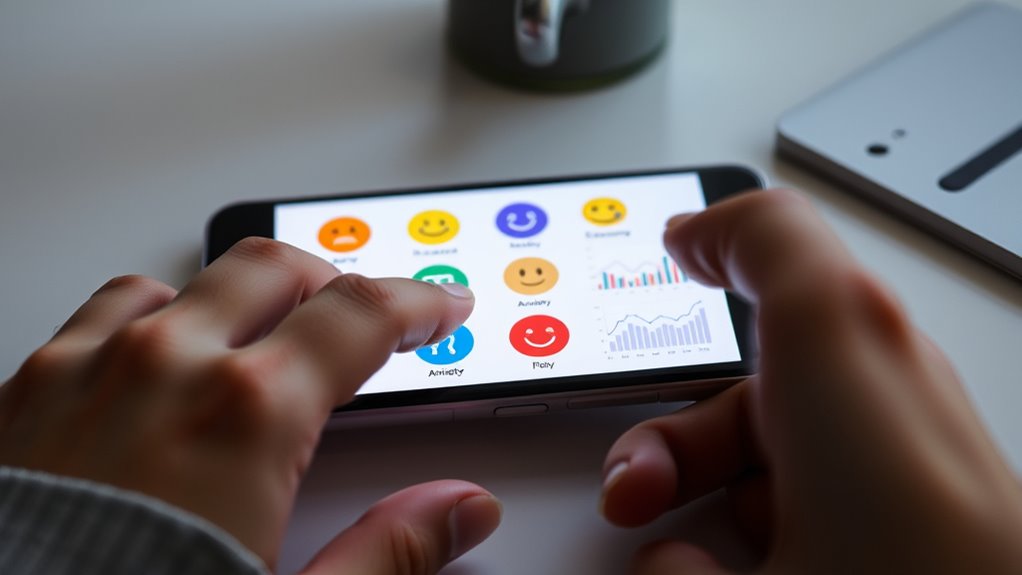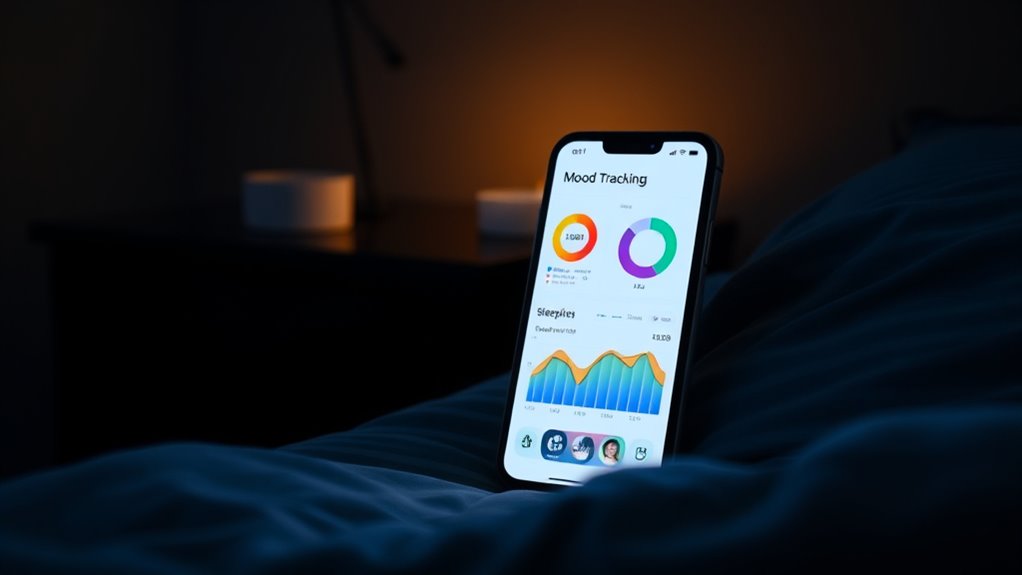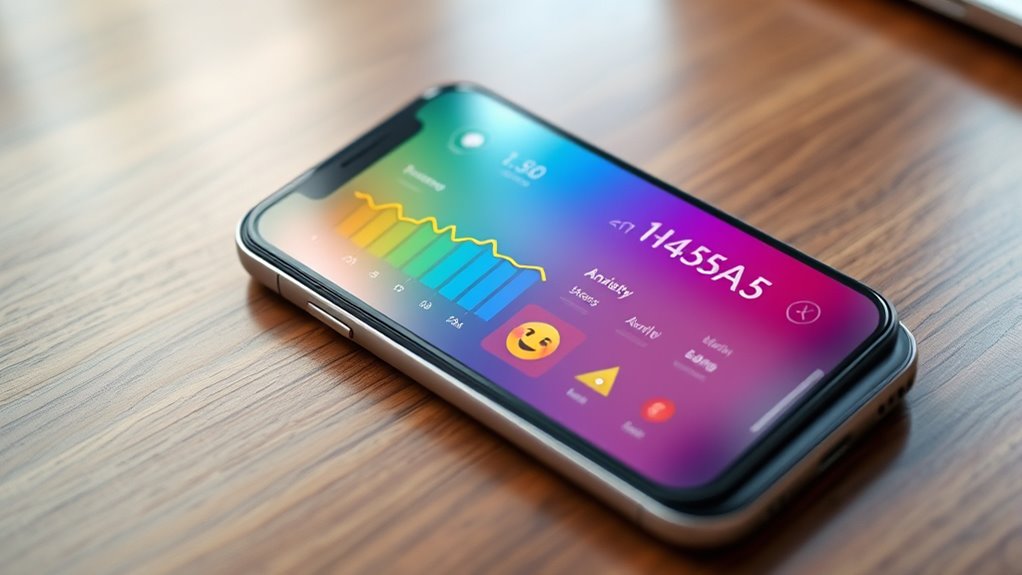When using mood tracking apps, focus on recording your mood ratings and emotional shifts regularly to spot patterns. Track sleep quality, duration, and wake times to see how rest impacts your mood. Include activity levels and physical movement, as exercise can boost your emotions. Monitor stress, anxiety, and external factors like environment or social interactions to understand their influence. Keep an eye on treatments and daily routines to gauge progress—there’s more to uncover as you continue exploring these essential metrics.
Key Takeaways
- Daily mood ratings to monitor emotional fluctuations and identify patterns over time.
- Sleep quality and duration metrics to assess their impact on emotional well-being.
- Stress and anxiety levels tracking to understand their influence on mood changes.
- Social interaction frequency and support network engagement for emotional resilience insights.
- Treatment adherence and routine consistency to evaluate their effects on mood stability.
Tracking Mood Ratings and Emotional Fluctuations

Tracking your mood ratings allows you to observe patterns and identify emotional fluctuations over time. By regularly recording how you feel, you create an emotional baseline—a reference point for your typical mood. This helps you recognize when your mood varies markedly, highlighting periods of heightened mood variability. Monitoring these fluctuations reveals triggers or circumstances that influence your emotions, giving you insight into your mental health. Consistent tracking makes it easier to see if your mood shifts are temporary or part of a larger pattern. Over time, this data can inform you about your emotional stability and help you develop strategies to manage mood swings. Recognizing these patterns empowers you to take proactive steps toward improving your overall emotional well-being.
Sleep Patterns and Quality Indicators

Your sleep patterns greatly influence your mood, so tracking sleep duration and consistency can reveal important insights. Pay attention to how restful you feel and how often you experience deep sleep, as these factors impact your emotional well-being. Understanding these indicators helps you identify habits that improve both your sleep quality and overall mood. Incorporating sleep analysis can further enhance your understanding of your sleep patterns and their effect on your mood.
Sleep Duration and Consistency
Consistent sleep duration and quality are essential indicators of overall well-being, and mood tracking apps often help users monitor these patterns to identify potential issues. By tracking sleep duration, you can notice if irregularities coincide with mood changes, while consistent sleep supports emotional stability. Improving bedtime routines can enhance sleep quality and may boost dream recall, providing insights into subconscious thoughts impacting your mood. Apps may prompt you to log sleep times, helping you establish regular sleep schedules. When your sleep duration varies considerably or your routines are inconsistent, it can lead to mood swings or fatigue. Monitoring these metrics allows you to make adjustments, fostering better sleep habits and, ultimately, a healthier emotional state. Incorporating sleep tracking features from these apps can further refine your understanding of your sleep patterns.
Restfulness and Deep Sleep
Since restful, deep sleep plays a crucial role in emotional resilience, monitoring these aspects can provide valuable insights into your overall mental health. Deep sleep boosts mood stability, memory, and recovery, making it essential to track. Pay attention to your dream recall, as vivid dreams may indicate the quality of your REM cycles. Your sleep environment also influences restfulness, including factors like room temperature, light, and noise levels. Using a sleep tracker, you can identify patterns and make adjustments to improve sleep quality. Being aware of sleep environment factors can help optimize your sleep conditions and enhance overall restfulness.
Activity Levels and Physical Movement

Have you ever noticed how physical activity influences your mood? When you track your activity levels, you gain insights into how exercise impacts your emotions. Using exercise tracking features in your app, you can monitor your daily movement and see patterns that correlate with better or worse moods. Paying attention to calorie expenditure helps you understand how active you’ve been and how it affects your mental state. Regular movement releases endorphins, boosting your mood naturally. By recording activities like walking, running, or biking, you can identify which exercises help you feel more energized and balanced. Keeping track of physical movement isn’t just about fitness; it’s a valuable tool for understanding and managing your emotional well-being. Incorporating pressure relief options such as supportive mattresses can further enhance the benefits of physical activity on your mood.
Stress Levels and Anxiety Indicators

Ever wonder how tracking your stress levels and anxiety indicators can help you better understand your emotional health? Monitoring these metrics reveals how daily habits and environmental influences impact your mood. Recognizing patterns can guide you to incorporate mindfulness practices that reduce anxiety. Environmental factors like noise, lighting, or social settings often amplify stress, so awareness allows you to make strategic adjustments. Tracking tools can also highlight triggers linked to specific times or activities. Consider these insights:
- Fluctuations correlated with environmental changes
- Effectiveness of mindfulness practices over time
- Identifying stress triggers in daily routines
- Impact of social interactions on anxiety
- Patterns that inform relaxation strategies
- Understanding how contrast ratio affects perception and mood
With accurate tracking, you gain a clearer picture of what influences your stress, empowering you to take targeted action.
Sleep and Wake Timing Trends
Did you know that tracking your sleep and wake timing can reveal important patterns affecting your overall well-being? By logging when you go to bed and wake up, you can identify habits that influence your mood and energy levels. Incorporate dream journaling to understand how your sleep quality impacts your mental health, noticing if vivid dreams correlate with better or worse days. Consistent sleep schedules support stable moods, so observing trends helps you refine your morning routines for better mental clarity. These insights can motivate you to adjust bedtime, reduce screen time before sleep, or adopt relaxing rituals. Tracking sleep and wake times creates a clearer picture of your daily rhythm, empowering you to make informed choices that enhance your mood and overall health. For additional support, visiting our ourmindandbody.com can provide helpful resources.
Social Interactions and Connectivity

Your social interactions and connections can considerably influence your mood, especially when tracked over time. Monitoring how often you engage with others and the strength of your support network reveals patterns that impact your well-being. Understanding this connectivity helps you see how social support can boost or, in some cases, challenge your emotional health. Incorporating positive relationship practices into your routine can further enhance the beneficial effects of social interaction on your mental health.
Interaction Frequency Patterns
Tracking how often you interact with others through mood apps reveals important patterns in your social connectivity. Monitoring engagement frequency helps you understand your behavior patterns and how they influence your mood. Consistent interactions may indicate stable social bonds, while fluctuations could signal emotional shifts or social withdrawal. Recognizing these patterns enables you to identify triggers that impact your well-being. By analyzing your interaction frequency, you can gauge your social engagement levels and make informed adjustments. Insights gained may highlight periods of increased connection or isolation, helping you address potential issues proactively. Ultimately, understanding your behavior patterns around social connectivity empowers you to cultivate healthier relationships and maintain emotional balance. Notably, interaction frequency can serve as a useful indicator of overall mental health, guiding you toward more balanced social habits.
Social Support Networks
Monitoring how often you connect with others through mood tracking apps reveals the strength and breadth of your social support network. By tracking your interactions, you gain insight into your community engagement and how it influences your mood. Regular online support, whether through messaging, forums, or shared activities, can help you feel connected and understood. These connections provide emotional backing, reduce feelings of isolation, and bolster resilience during tough times. Recognizing patterns in your social interactions can highlight gaps or strengths in your support system. Additionally, understanding the role of security features in your digital interactions can help protect your privacy while maintaining meaningful connections. Ultimately, understanding your social support network helps you build healthier relationships and prioritize activities that foster connection, which plays a essential role in maintaining positive mental health.
Connectivity Impact on Mood
Have you ever noticed how a simple chat or shared activity can lift your mood? Connectivity plays a crucial role in mental well-being, especially through social interactions and online support. Engaging in group therapy sessions or connecting with others via apps can boost your emotional resilience. These interactions foster a sense of belonging, reduce feelings of isolation, and provide valuable perspectives. The impact of connectivity on mood can be enhanced by:
- Regular participation in online support communities
- Virtual group therapy sessions for shared experiences
- Real-time messaging with trusted contacts
- Participating in social challenges or activities via apps
- Maintaining consistent communication with loved ones
Additionally, incorporating eye patches into your self-care routine can help improve your overall sense of well-being by reducing fatigue and refreshing your appearance.
Medication and Treatment Effects

Medication and treatment effects play a crucial role in managing mood disorders, and mood tracking apps can help you see how different therapies influence your mental health. By monitoring your mood alongside medication adherence, you can identify patterns that show whether your treatment is working. Tracking medication intake and noting side effects give you concrete data to assess treatment effectiveness. If you notice mood improvements following medication adjustments, you can discuss these insights with your healthcare provider. Conversely, tracking any negative effects helps you and your doctor make informed decisions about your treatment plan. Overall, using a mood tracking app to observe how medications and therapies impact your mood empowers you to take an active role in your mental health management.
Day-to-Day Context and External Factors

External factors and daily routines can heavily influence your mood, often more than you realize. Environmental influences such as weather, noise levels, and social interactions shape how you feel throughout the day. Your daily routines, including sleep patterns, meal times, and work schedules, also play a vital role in mood stability. Recognizing these external factors helps you understand mood fluctuations better. Consider these influences:
- Weather changes impacting energy and motivation
- Social interactions affecting emotional well-being
- Sleep quality altering mood and focus
- Work stressors disrupting daily routines
- Environmental noise influencing relaxation or agitation
Tracking these external factors alongside your mood provides a fuller picture, empowering you to identify patterns and make targeted adjustments for improved mental health.
Frequently Asked Questions
How Do Mood Tracking Apps Protect My Privacy and Data Security?
You might wonder how mood tracking apps protect your privacy and data security. These apps typically use strong privacy safeguards, like anonymizing your data and giving you control over what you share. They also implement data encryption, which keeps your information secure during transmission and storage. Always check the app’s privacy policy to understand their specific security measures. This way, you can confidently track your mood while safeguarding your personal information.
Can Mood Metrics Predict Future Mental Health Episodes Accurately?
Imagine your mood metrics as whispers from your mind’s subtle signals. While predictive modeling uses these clues to forecast future mental health episodes, it’s not foolproof. You might see promising data accuracy, but predictions can still be off. It’s essential to view these tools as helpful guides rather than crystal balls, empowering you to stay aware, seek support early, and maintain your mental wellness journey with informed optimism.
Are There Recommended Frequencies for Logging Mood to Ensure Effectiveness?
When considering how often you should log your mood, aim for frequency consistency to keep your data reliable. Daily or several times a week works well for most people, helping improve reporting accuracy. Too infrequent logging may miss important patterns, while excessive entries could become burdensome. Find a rhythm that fits your lifestyle, ensuring consistent tracking without feeling overwhelmed, so your mood data remains meaningful and actionable.
How Do Different Demographics Influence the Choice of Mood Tracking Metrics?
You should consider how demographic preferences and cultural influences shape the metrics you choose to track. Different age groups, backgrounds, and lifestyles prioritize various aspects of mood, like energy levels or social interactions. Recognizing these differences helps you select relevant metrics that resonate with your personal experiences, making your mood tracking more meaningful and effective. Tailoring your approach guarantees you capture insights that genuinely reflect your unique demographic context.
What Are Common Pitfalls or Inaccuracies in Self-Reported Mood Data?
Beware of biased, blurry boundaries in your self-reporting; reporting bias and inaccurate self-assessment can distort your data. When you record moods, you might overstate positives or understate negatives, skewing your insights. This inconsistency complicates understanding your true emotional state. To improve, be honest and precise, recognizing that subjective snapshots may sometimes stray from your actual feelings, ensuring your mood metrics remain meaningful and manageable.
Conclusion
Tracking your mood and related metrics can reveal surprising patterns—like how consistent sleep improves overall well-being. Did you know that people who log their moods regularly are 2.5 times more likely to notice early signs of emotional shifts? By paying attention to sleep, activity, and social interactions, you can better understand what influences your mental health. Keep monitoring; your insights could be the key to feeling more balanced and in control every day.









